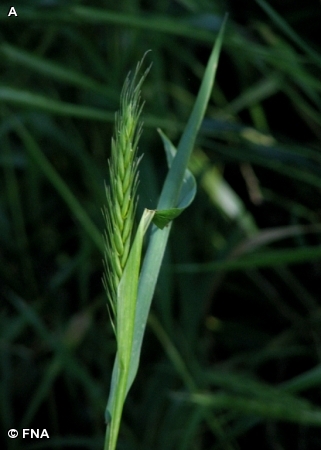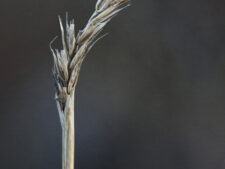
A native perennial growing singly or in bunches, sometimes forming large colonies on the floodplain. Flowering stems of this plant, which is quite variable in size and growth habit, are from 1-5 feet tall. The stiff and straight flowering spikes are usually partially enclosed by the uupper leaf sheath (A) and are 1 1/2 to 6 inches long. Characteristic straplike, U-shaped glumes (D) provide a good field mark. When mature, the glumes and enclosed seeds fall together leaving a naked stem (E).
Floodplain woodlands, streambanks, low prairies, woodland edges. In Fontenelle Forest, Virginia Wild Rye is common along Marsh Trail and the Gifford Memorial Boardwalk. At Neale Woods it is not as common, but there are good populations on River Trail. Flowering occurs from late May to July.
Hairy Wild Rye (Elymus villosus) has nodding spikes projecting well above the leaves and narrow, straight glumes which are retained on the stem when the seeds fall. Canada Wild Rye (Elymus canadensis) has larger nodding spikes, and the florets have long curved and twisted awns giving the spike a “shaggy” appearance. Virginia Wild Rye and Bottlebrush Grass (Elymus hystrix) both drop their seeds and coverings (glumes) at maturity leaving similar “naked” stems that persist through the fall and winter (E). Close examination shows the stems of Bottlebrush Grass to be more slender, with knobbier projections where the spikelets were previously attached.
The content of NatureSearch is provided by dedicated volunteer Naturalists of Fontenelle Forest who strive to provide the most accurate information available. Contributors of the images retain their copyrights. The point of contact for this page is: Neal Ratzlaff.





